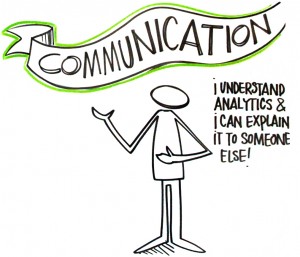Reflecting on my 25 years as a data analyst, I’ve always felt that there is something more to being a good applied statistician than just applying what I had learned from school. What are those key skills that make a good field statistician?
Before analytics came into play, when presented with a real world business problem, we depended on business experts or even fortune tellers to conjure a business solution. Those approaches delivered results that were better than random guessing but inconsistent because they were often very subjective. Over time, seeking an alternative solution, more of these problems have falling into the hands of analytical consultants.
How do analytical consultants approach these problems? The typical work flow follows these four steps:
- Formulate the question as a business problem.
- Break the business problem down into component analytical problems.
- Use the results to develop an analytical solution.
- Explain the analytical solution in terms of a business solution.
The strengths of statisticians lie in quantifying and analyzing data, numbers and figures. Needless to say, this is the most important and necessary aspect of a good analytic consultant. But, by itself, it is not enough to be a great one. Greatness demands something more. The ability to translate the customer’s business problem into an analytical problem is the first important skill to have. And sometimes, the translation requires industry or domain specific knowledge.
Once the analytic problem is formulated, the next step is the quantification process. Using all analytical knowledge, the analytical problems are addressed. The more you know about statistics and use your imagination and creativity, the higher the chance that your analytical results will be better suited to solve the problem. Quantitative Creativity addressed in my colleague Anthony’s previous post, points out why we need this skill. Even with the same tools, the outcome can be completely different.

After the analytic problem solving is done, delivering the analytical solution to represent a business solution is the last key skill to have. This is a soft skill and the ability to communicate with a non-analytical audience is a key to becoming a great analytical consultant. There are many cases, where important analytical value was lost due to poor presentation of results. Visualization of analytic results is a great way to communicate with individuals with limited or no analytic background. Sometimes, a less experienced analytical consultant will stop at an analytical finding and expect the customer to visualize and interpret the result. Analysts need to throw-in that last pitch to ensure we completely fulfill our customer’s needs.
Finally, a lot of statistical approaches are related to minimizing error (or failures), so statisticians tend to apply those in their life unconsciously. As a result, statisticians tend to put more weight on avoiding failures, leading to being overly-cautious or passive. We all know that it is ok to have failed. In order to creatively improve the required skill sets that form a great statistician, failure is unavoidable. So I challenge my fellow statistician; be brave, do less hedging and trust your skills.

3 Comments
An excellent and valuable blog. Can understand and appreciate the suggestions. Businesses don't always have a clear understanding how Statistics / Anlytics is as much of an art as it is a science.
Had been in situations where the business sponsors clearly throw cold water over the analysis / conclusions of the project and quite often will say that they could have told the Analyst from their experience.
what is analytics?i cant understand.plz explain.
Analytics--1)Data
2)Business Insight
3)Statistics
4)Business Solution
5) More ROI